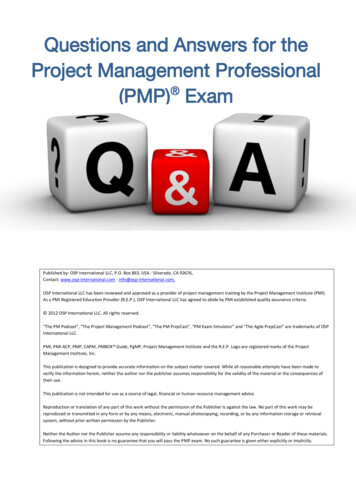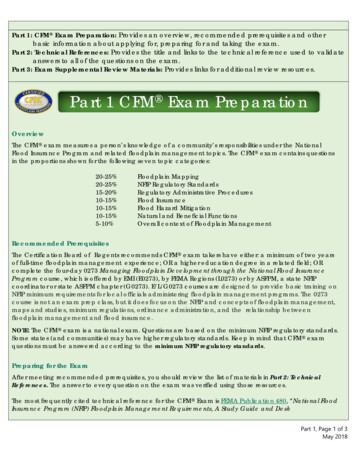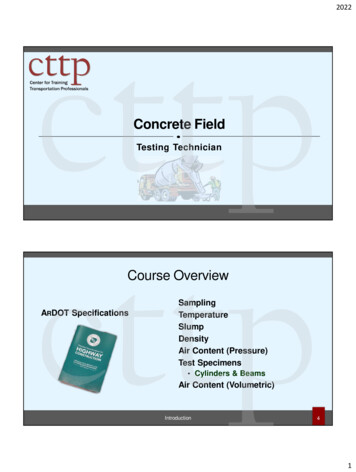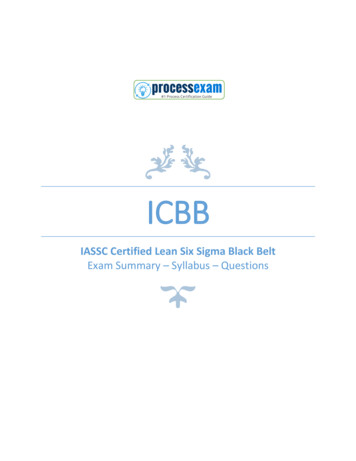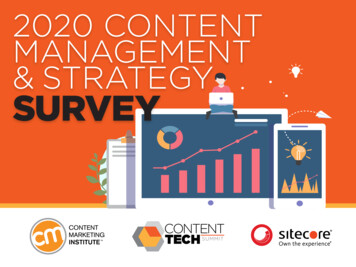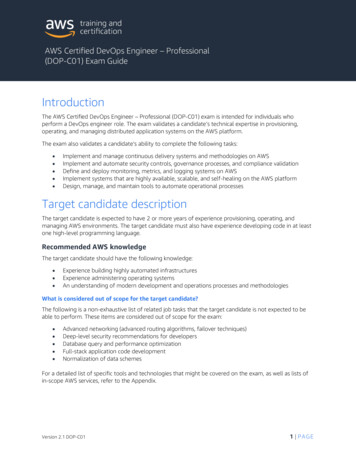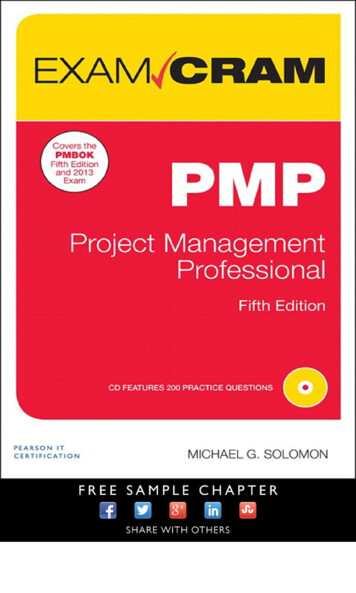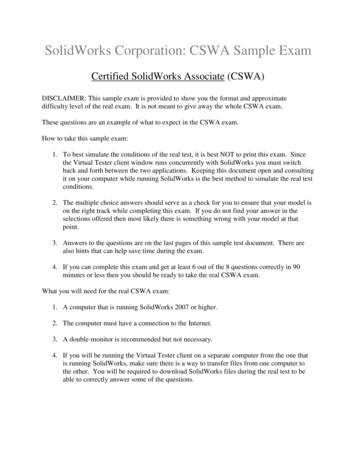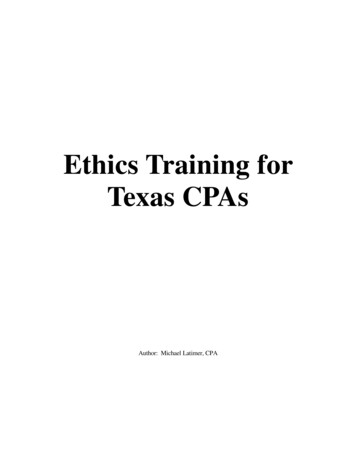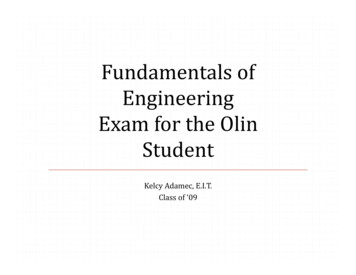
Transcription
PgMP Program Management Professional (PgMP)Examination Content Outline
Project Management InstituteProgram Management Professional (PgMP )Examination Content OutlineApril 2011
Published by:Project Management Institute, Inc.14 Campus BoulevardNewtown Square, Pennsylvania 19073-3299 USA.Phone: 610-356-4600Fax: 610-356-4647E-mail: customercare@pmi.orgInternet: www.PMI.org 2011 Project Management Institute, Inc. All rights reserved."PMI", the PMI logo, "PMP", the PMP logo, "PMBOK", "PgMP”, “Project Management Journal", "PMNetwork", and the PMI Today logo are registered marks of Project Management Institute, Inc. TheQuarter Globe Design is a trademark of the Project Management Institute, Inc. For a comprehensive listof PMI marks, contact the PMI Legal Department
TABLE OF CONTENTSIntroduction . 1Key Findings and Conclusions .3Exam Content Outline. 5Domains, Tasks, and Knowledge and Skill Statements . 6Performance Domain I: Strategic Program Management . 6Performance Domain II: Program Life Cycle . 8Performance Domain III: Benefits Management . 13Performance Domain IV: Stakeholder Management . 14Performance Domain V: Governance . 15Cross-Cutting Knowledge and Skills . 17Appendix A . 20
INTRODUCTIONThe Project Management Institute (PMI ) offers a professional credential for programmanagers, known as the Program Management Professional (PgMP ). PMI’s professionalcredentialing examination development processes stand apart from other project managementcertification examination development practices. PMI aligns its process with certificationindustry best practices, such as those found in the Standards for Educational and PsychologicalTesting.A key component of this process is that organizations wishing to offer valid and reliableprofessional credentialing examinations are directed to use a role delineation study (RDS) as thebasis for the creation of the examination. This process utilizes knowledge and task drivenguidelines to assess the practitioners’ competence, and determine the level of salience, criticality,and frequency of each of the knowledge, tasks, and skills required to perform to the industrywide standard in the role of a program manager.The role delineation study ensures the validity of an examination. Validation assures theoutcome of the exam is in fact measuring and evaluating appropriately the specific knowledgeand skills required to function as a program management professional. Thus, the role delineationstudy guarantees that each examination validly measures all elements of the programmanagement profession in terms of real settings.PgMP credential holders can be confident that their professional credential has beendeveloped according to best practices of test development and based upon input from thepractitioners who establish those standards. Please see Appendix A for a detailed description ofthe process.The PgMP examination is a vital part of the activities leading to earning a professionalcredential, thus it is imperative that the PgMP examination reflect accurately the practices of theprogram management professional. All the questions on the examination have been written andextensively reviewed by qualified PgMP credential holders and tracked to at least two academicreferences. These questions are mapped against the PgMP Examination Content Outline toensure that an appropriate number of questions are in place for a valid examination.PMI retained Professional Examination Service (PES) to develop the global PgMPExamination Content Outline. Since 1941, Professional Examination Service (PES) has provideda full range of assessment and advisory services to organizations across a broad range ofprofessions, in support of professional licensure and certification, training, and continuingprofessional education. PES is dedicated to promoting the public welfare through credentialingas a mission-driven, not-for-profit organization.Finally, while the PgMP Examination Content Outline and the The Standard for ProgramManagement have commonalities, it is important to note that those involved in the studydescribed previously were not bound by the The Standard for Program Management. They were 2011 Project Management Institute, Inc. All rights reserved.PMI PgMP Examination Content Outline – April 20111
charged with defining the role of individuals leading and directing programs, and using theirexperience and pertinent resources to help in this task.Many of the domains, tasks, knowledge, and skills outlined by the PgMP ExaminationContent Outline are new, revised, or reclassified in comparison to what is found in The Standardfor Program Management. Candidates studying for the examination will certainly want toinclude the current edition of the The Standard for Program Management as one of theirreferences, and would be well advised to read other current titles on program management. 2011 Project Management Institute, Inc. All rights reserved.PMI PgMP Examination Content Outline – April 20112
KEY FINDINGS AND CONCLUSIONSThe task force developed a model that fundamentally restructured the then-existingdelineation of program management practice. Accordingly, rather than mirroring the six lifecycle domains utilized in the PMP model, the revised PgMP delineation comprises five domainsof practice, including four new overarching domains and one domain incorporating life cycletasks. The new framework provides a clear, concise, comprehensive, and contemporarydescription of program management practice and accurately reflects the higher-level businessfunctions that are essential aspects of the program manager’s job—regardless of size oforganization, industry or business focus, and/or geographic location. The structure is organizedas follows:Domain 1: Strategic Program ManagementIdentifying opportunities and benefits that achieve the organization’sstrategic objectives through program implementationDomain 2: Program Life CycleActivities related to: Initiating. Defining the program and constituent projects, and obtainingagreement from stakeholdersPlanning. Defining program scope and developing the program,including all constituent projects, and all activities that occur within theprogram Executing. Performing work necessary to achieve the program’sobjectives and deliver the program’s benefits Controlling. Monitoring progress, updating program plans as required,managing change and risk Closing. Finalizing all program activities, including all constituentprojects, executing transition plan, archiving, obtaining approvals, andreportingDomain 3: Benefits Management Defining, creating, maximizing, and sustaining the benefits provided byprogramsDomain 4: Stakeholder ManagementCapturing stakeholder needs and expectations, gaining and maintainingstakeholder support, and mitigating/channeling opposition 2011 Project Management Institute, Inc. All rights reserved.PMI PgMP Examination Content Outline – April 20113
Domain 5: GovernanceEstablishing processes and procedures for maintaining proactive programmanagement oversight and decision-making support for applicable policiesand practices throughout the entire program life cycleIn addition to restructuring the domains, the task force revised existing tasks, developed newtasks, reviewed and restructured the knowledge and skills associated with each domain, anddeveloped a core list of knowledge and skills applicable across all domains. The final modelcontains 72 tasks and 126 knowledge and skills. 2011 Project Management Institute, Inc. All rights reserved.PMI PgMP Examination Content Outline – April 20114
EXAM CONTENT OUTLINEThe following table identifies the proportion of questions from each domain that will appearon the examination. These percentages are used to determine the number of questions related toeach domain and task that should appear on the multiple-choice format examination.Domain/Subdomain% of ExamI.Strategic Program Management (11 tasks)15%II.Program Life Cycle (35 tasks)44% Initiating (6 tasks)6% Planning (9 tasks)11% Executing (9 tasks)14% Controlling (6 tasks)10% Closing (5 tasks)3%III. Benefits Management (8 tasks)11%IV. Stakeholder Management (7 tasks)16%V.14%Governance (11 tasks)The revised conceptual framework describing the work of program managers, including thefour overarching domains of practice which impact the Program Life Cycle domain, wasvalidated through this RDS. This new structure calls attention to the clear distinctions whichexist between the jobs of PMP credential holders and PgMP credential holders, especially in theview of the critical importance to the profession of program management for the tasks associatedwith the new domains of Strategic Program Management, Benefits Management, StakeholderManagement, and Governance. 2011 Project Management Institute, Inc. All rights reserved.PMI PgMP Examination Content Outline – April 20115
DOMAINS, TASKS, AND KNOWLEDGE AND SKILLSOF PROGRAM MANAGERSDomain IStrategic Program ManagementTask 1Perform an initial program assessment by defining the programobjectives, requirements, and risks in order to ensure programalignment with the organization’s strategic plan, objectives, priorities,vision, and mission statement.Task 2Establish a high-level road map with milestones and preliminaryestimates in order to obtain initial validation and approval from theexecutive sponsor.Task 3Define the high-level road map/framework in order to set a baseline forprogram definition, planning, and execution.Task 4Define the program mission statement by evaluating the stakeholders’concerns and expectations in order to establish program direction.Task 5Evaluate the organization’s capability by consulting withorganizational leaders in order to develop, validate, and assess theprogram objectives, priority, feasibility, readiness, and alignment tothe organization’s strategic plan.Task 6Identify organizational benefits for the potential program usingresearch methods such as market analysis and high-level cost-benefitanalysis in order to develop the preliminary program scope and definebenefits realization plan.Task 7Estimate the high level financial and nonfinancial benefits of theprogram in order to obtain/maintain funding authorization and driveprioritization of projects within the program.Task 8Evaluate program objectives relative to regulatory and legalconstraints, social impacts, sustainability, cultural considerations,political climate, and ethical concerns in order to ensure stakeholderalignment and program deliverability.Task 9Obtain organizational leadership approval for the program bypresenting the program charter with its high-level costs, milestoneschedule and benefits in order to receive authorization to initiate theprogram.Task 10Identify and evaluate integration opportunities and needs (for example,human capital and human resource requirements and skill sets,facilities, finance, assets, processes, and systems) within programactivities and operational activities in order to align and integratebenefits within or across the organization. 2011 Project Management Institute, Inc. All rights reserved.PMI PgMP Examination Content Outline – April 20116
Domain ITask 11Strategic Program ManagementExploit strategic opportunities for change in order to maximize therealization of benefits for the organization.Knowledge specific to Domain 1(*Indicates knowledge is found in one other domain, shown in parentheses) Business strategyBusiness/organization objectives* (V)Economic forecastingFeasibility analysisFinancial measurement and management techniquesFunding modelsFunding processesIntellectual property laws and guidelinesLegal and regulatory requirementsMarketingPortfolio managementProgram and constituent project charter development* (II)Program mission and visionPublic relations* (IV)Requirement analysis techniquesScenario analysisStrategic planning and analysis* (II)System implementation models and methodologiesTrend analysis 2011 Project Management Institute, Inc. All rights reserved.PMI PgMP Examination Content Outline – April 20117
Domain IIProgram Life CycleInitiating the ProgramTask 1Develop program charter using input from all stakeholders, includingsponsors, in order to initiate and design program and benefits.Task 2Translate strategic objectives into high-level program scopestatements by negotiating with stakeholders, including sponsors, inorder to create a program scope description.Task 3Develop a high-level milestone plan using the goals and objectives ofthe program, applicable historical information, and other availableresources (for example, work breakdown structure (WBS), scopestatements, benefits realization plan) in order to align the program withthe expectations of stakeholders, including sponsors.Task 4Develop an accountability matrix by identifying and assigning programroles and responsibilities in order to build the core team and todifferentiate between the program and project resources.Task 5Define standard measurement criteria for success for all constituentprojects by analyzing stakeholder expectations and requirementsacross the constituent projects in order to monitor and control theprogram.Task 6Conduct program kick-off with key stakeholders by holding meetingsin order to familiarize the organization with the program and obtainstakeholder buy-in. 2011 Project Management Institute, Inc. All rights reserved.PMI PgMP Examination Content Outline – April 20118
Domain IIProgram Life CyclePlanning the ProgramTask 7Develop a detailed program scope statement by incorporating programvision and all internal and external objectives, goals, influences, andvariables in order to facilitate overall planning.Task 8Develop program WBS in order to determine, plan, and assign theprogram tasks and deliverables.Task 9Establish the program management plan and schedule by integratingplans for constituent projects and creating plans for supportingprogram functions (for example, quality, risk, communication,resources) in order to effectively forecast, monitor, and identifyvariances during program execution.Task 10Optimize the program management plan by identifying, reviewing, andleveling resource requirements (for example, human resources,materials, equipment, facilities, finance) in order to gain efficienciesand maximize productivity/synergies among constituent projects.Task 11Define project management information system (PMIS) by selectingtools and processes to share knowledge, intellectual property, anddocumentation across constituent projects in order to maximizesynergies and savings in accordance with the governance model.Task 12Identify and manage unresolved project-level issues by establishing amonitoring and escalation mechanism and selecting a course of actionconsistent with program constraints and objectives in order to achieveprogram benefits.Task 13Develop the transition/integration/closure plan by defining exit criteriain order to ensure all administrative, commercial, and contractualobligations are met upon program completion.Task 14Develop key performance indicators (KPIs) by using decomposition/mapping/ balanced score card (BSC) in order to implement scope andquality management system within program.Task 15Monitor key human resources for program and project roles, includingsubcontractors, and identify opportunities to improve team motivation(for example, develop compensation, incentive, and career alignmentplans) and negotiate contracts in order to meet and/or exceed benefitsrealization objectives. 2011 Project Management Institute, Inc. All rights reserved.PMI PgMP Examination Content Outline – April 20119
Domain IIProgram Life CycleExecuting the ProgramTask 16Charter and initiate constituent projects by assigning projectmanagers and allocating appropriate resources in order to achieveprogram objectives.Task 17Establish consistency by deploying uniform standards, resources,infrastructure, tools, and processes in order to enable informedprogram decision making.Task 18Establish a communication feedback process in order to capturelessons learned and the team’s experiences throughout the program.Task 19Lead human resource functions by training, coaching, mentoring, andrecognizing the team in order to improve team engagement andachieve commitment to the program’s goals.Task 20Review project managers’ performance in executing the project inaccordance with the project plan in order to maximize theircontribution to achieving program goals.Task 21Execute the appropriate program management plans (for example,quality, risk, communication, resourcing) using the tools identified inthe planning phase and by auditing the results in order to ensure theprogram outcomes meet stakeholder expectations and standards.Task 22Consolidate project and program data using predefined program planreporting tools and methods in order to monitor and control theprogram performance and communicate to stakeholders.Task 23Evaluate the program’s status in order to monitor and control theprogram while maintaining current program information.Task 24Approve closure of constituent projects upon completion of defineddeliverables in order to ensure scope is compliant with the functionaloverview. 2011 Project Management Institute, Inc. All rights reserved.PMI PgMP Examination Content Outline – April 201110
Domain IIProgram Life CycleControlling the ProgramTask 25Analyze variances and trends in costs, schedule, quality, and risks bycomparing actual and forecast to planned values in order to identifycorrective actions or opportunities.Task 26Update program plans by incorporating corrective actions to ensureprogram resources are employed effectively in order to meet programobjectives.Task 27Manage program level issues (for example, human resourcemanagement, financial, technology, scheduling) by identifying andselecting a course of action consistent with program scope,constraints, and objectives in order to achieve program benefits.Task 28Manage changes in accordance with the change management plan inorder to control scope, quality, schedule, cost, contracts, risks, andrewards.Task 29Conduct impact assessments for program changes and recommenddecisions in order to obtain approval in accordance with thegovernance model.Task 30Manage risk in accordance with the risk management plan in order toensure benefits realization.Closing the ProgramTask 31Complete a program performance analysis report by comparing finalvalues to planned values for scope, quality, cost, schedule, andresource data in order to determine program performance.Task 32Obtain stakeholder approval for program closure in order to initiateclose-out activities.Task 33Execute the transition and/or close-out of all program and constituentproject plans (for example, perform administrative and PMIS programclosure, archive program documents and lessons learned, and transferongoing activities to functional organization) in order to meet programobjectives and/or ongoing operational sustainability.Task 34Conduct the post-review meeting by presenting the programperformance report in order to obtain feedback and capture lessonslearned.Task 35Report lessons learned and best practices observed and archive to theknowledge repository in order to support future programs andorganizational improvement. 2011 Project Management Institute, Inc. All rights reserved.PMI PgMP Examination Content Outline – April 201111
Domain IIProgram Life CycleKnowledge Specific to Domain 2(*Indicates knowledge is found in one other domain, shown in parentheses) BenchmarkingCloseout plans, procedures, techniques and policies* (5)Decomposition techniques (for example, work breakdownstructure (WBS))Financial closure processes* (V)Logistics managementPerformance and quality metrics* (III)Phase gate reviews* (V)Procurement managementProduct/service development phasesProgram and constituent project charter development* (I)Program and project change requests* (V)Program initiation planProgram management plansQuality control and management tools and techniquesResource estimation (human and material)Resource leveling techniquesRoot cause analysisSchedule management, techniques, and toolsScope managementService level agreementsStatistical analysis* (V)Strategic planning and analysis* (I)SWOT analysisTalent evaluationTeam competency assessment techniquesTraining methodologies* (IV) 2011 Project Management Institute, Inc. All rights reserved.PMI PgMP Examination Content Outline – April 201112
Domain IIIBenefits ManagementTask 1Develop the benefits realization plan and its measurement criteria inorder to set the baseline for the program and communicate tostakeholders, including sponsors.Task 2Identify and capture synergies and efficiencies identified throughoutthe program life cycle in order to update and communicate thebenefits realization plan to stakeholders, including sponsors.Task 3Develop a sustainment plan that identifies the processes, measures,metrics, and tools necessary for management of benefits beyond thecompletion of the program in order to ensure the continued realizationof intended benefits.Task 4Monitor the metrics (for example, by forecasting, analyzing variances,developing “what if” scenarios and simulations, and utilizing causalanalysis) in order to take corrective actions in the program andmaintain and/or potentially improve benefits realization.Task 5Verify that the close, transition, and integration of constituent projectsand the program meet or exceed the benefit realization criteria in orderto achieve program’s strategic objectives.Task 6Maintain a benefit register and record program progress in order toreport the benefit to stakeholders via the communications plan.Task 7Analyze and update the benefits realization and sustainment plans foruncertainty, risk identification, risk mitigation, and risk opportunity inorder to determine if corrective actions are necessary andcommunicate to stakeholders.Task 8Develop a transition plan to operations in order to guaranteesustainment of products and benefits delivered by the program.Knowledge Specific to Domain III(*Indicates knowledge is found in one other domain, shown in parentheses) Benefit optimizationBusiness value measurementDecision tree analysisMaintenance and sustainment of program benefits postdeliveryPerformance and quality metrics* (II)Program transition strategies 2011 Project Management Institute, Inc. All rights reserved.PMI PgMP Examination Content Outline – April 201113
Domain IVStakeholder ManagementTask 1Identify stakeholders, including sponsors, and create the stakeholdermatrix in order to document their position relative to the program.Task 2Perform stakeholder analysis through historical analysis, personalexperience, interviews, knowledge base, review of formal agreements(for example, request for proposal (RFP), request for information (RFI),contracts), and input from other sources in order to create thestakeholder management plan.Task 3Negotiate the support of stakeholders, including sponsors, for theprogram while setting clear expectations and acceptance criteria (forexample, KPIs) for the program benefits in order to achieve andmaintain their alignment to the program objectives.Task 4Generate and maintain visibility for the program and confirmstakeholder support in order to achieve the program’s strategicobjectives.Task 5Define and maintain communications adapted to differentstakeholders, including sponsors, in order to ensure their support forthe program.Task 6Evaluate risks identified by stakeholders, including sponsors, andincorporate them in the program risk management plan, as necessary.Task 7Develop and foster relationships with stakeholders, includingsponsors, in order to improve communication and enhance theirsupport for the program.Knowledge Specific to Domain IV(*Indicates knowledge is found in one other domain, shown in parentheses) Customer relationship managementCustomer satisfaction measurementExpectation managementPublic relations* (I)Training methodologies* (II) 2011 Project Management Institute, Inc. All rights reserved.PMI PgMP Examination Content Outline – April 201114
Domain VGovernanceTask 1Develop program and project management standards and structure(governance, tools, finance, and reporting) using industry bestpractices and organizational standards in order to drive efficiency andconsistency among projects and deliver program objectives.Task 2Select a governance model structure including policies, procedures,and standards that conforms program practices with theorganization’s governance structure in order to deliver programobjectives consistent with organizational governance requirements.Task 3Obtain authorization(s) and approval(s) through stage gate reviews bypresenting the program status to governance authorities in order toproceed to the next phase of the program.Task 4Evaluate key performance indicators (for example, risks, financials,compliance, quality, safety, stakeholder satisfaction) in order tomonitor benefits throughout the program life cycle.Task 5Develop and/or utilize the program management information system),and integrate different processes as needed, in order to manageprogram information and communicate status to stakeholders.Task 6Regularly evaluate new and existing risks that impact strategicobjectives in order to present an updated risk management plan to thegovernance board for approval.Task 7Establish escalation policies and procedures in order to ensure risksare handled at the appropriate level.Task 8Develop and/or contribute to an information repository containingprogram-related lessons learned, processes, and documentationcontributions in order to support organizational best practices.Task 9Identify and apply lessons learned in order to support and influenceexisting and future program or organizational improvement.Task 10Monitor the business environment, program functionalityrequirements, and benefits realization in order to ensure the programremains aligned with strategic objectives.Task 11Develop and support the program integration management plan inorder to ensure operational alignment with program strategicobjectives. 2011 Project Management Institute, Inc. All rights reserved.PMI PgMP Examination Content Outline – April 201115
Domain VGovernanceKnowledge Specific to Domain V(*Indicates knowledge is found in one other domain, shown in parentheses) Archiving tools and techniquesBusiness/organization objectives* (I)Closeout plans, procedures, techniques and policies* (II)Composition and responsibilities of the program managementoffice (PMO)Financial closure processes* (II)Go/no-go decision criteriaGovernance modelsGovernance processes and proceduresMetrics definition and measurement techniquesPerformance analysis and reporting techniques (for example,earned value analysis (EVA))Phase gate reviews* (II)Program and project change requests* (II)Statistical analysis* (II) 2011 Project Management Institute, Inc. All rights reserved.PMI PgMP Examination Content Outline – April 201116
CROSS-CUTTING KNOWLEDGE AND SKILLSCore Knowledge (Required in Three or More Domains):Three or MoreDomainsCore Knowledge Benefits measurement and analysis techniquesBrainstorming techniquesBudget processes and proceduresBusiness environmentBusiness ethicsBusiness models, structure, and organizationChange managementCoaching and mentoring techniquesCollaboration tools and techniquesCommunication tools and techniquesConflict resolution techniquesContingency planningContract negotiation/administrationContract typesCost-benefit techniquesCost managementCultural diversity/distinctionsData analysis/data miningDecision-making techniquesEmotional intelligenceHuman resource managementImpact assessment techniquesIndustry and market knowledgeInformation privacyKnowledge managementLeadership theories and techniquesManagement techniquesMotivational techniquesNegotiation strategies and techniquesOrganization strategic plan and visionPerformance management techniques (for example, costand time, performance against objectives) 2011 Project Management Institute, Inc. All rights reserved.PMI PgMP Examination Content Outline – April 201117
Three or MoreDomainsCore Knowledge Planning theory, techniques, and proceduresPMI Code of Ethics and Professional ConductPresentation tools and techniquesProblem-solving tools and techniquesProject Management Information Systems (PMIS)Reporting tools and techniquesRisk analysis techniquesRisk managementRisk mitigation and opportunities strategiesSafety standards and proceduresSocial responsibilitySuccession planningSustainability and environmental issuesTeam development and dynamics 2011 Project Management Institute, Inc. All rights reserved.PMI PgMP Examination Content Outline – April 201118
Core Skills (Required in All Domains)All DomainsCore Skills Active listeningAnalytical thinkingCapacity plannin
credential, thus it is imperative that the PgMP examination reflect accurately the practices of the program management professional. All the questions on the examination have been written and extensively reviewed by qualified PgMP credential holders and tracked to at least two academic references. These questions are mapped against the
